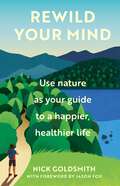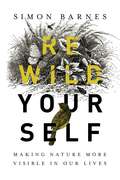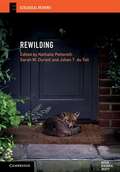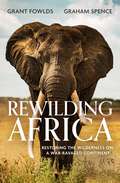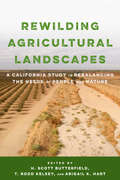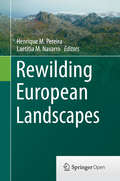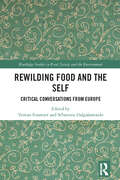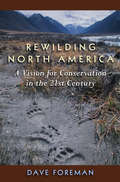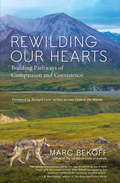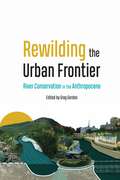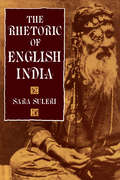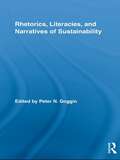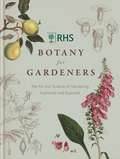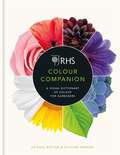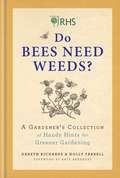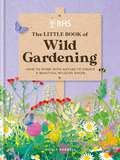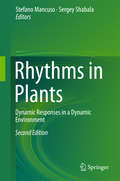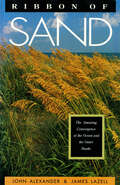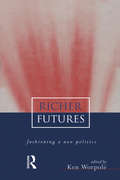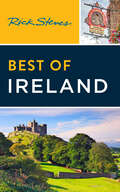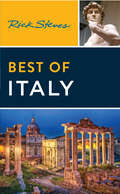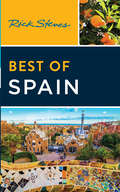- Table View
- List View
Rewild Your Mind: Use nature as your guide to a happier, healthier life
by Nick GoldsmithRewild Your Mind shows you how to connect with nature to be happier, healthier and more at peace with the world around you. Packed with wilderness skills and traditional crafts – from fixing a hammock in the woods and foraging for hedgerow medicine to finding moments of 'wild' in the everyday – this unique book enables readers to boost their wellbeing through getting outside. It is an invitation to reset, recharge and 'rewild' yourself. Weaved through the book is Nick Goldsmith's personal story of using nature to aid his recovery from PTSD. After several tours serving as a Royal Marine Commando in Afghanistan, Nick was left in a dark and desperate place. He tried conventional therapies but found true solace amongst nature, and now enables others to do the same.
Rewild Yourself: Making Nature More Visible In Our Lives
by Simon BarnesFor those readers who want to get closer to the nature all around them and bring it back into focus within their lives, this book is the ideal companion. We're not just losing the wild world. We're forgetting it. We're no longer noticing it. We've lost the habit of looking and seeing and listening and hearing. But we can make hidden things visible, and this book features numerous spellbinding ways to bring the magic of nature much closer to home. Mammals you never knew existed will enter your world. Birds hidden in treetops will shed their cloak of anonymity. With a single movement of your hand you can make reptiles appear before you. Butterflies you never saw before will bring joy to every sunny day. Creatures of the darkness will enter your consciousness. And as you take on new techniques and a little new equipment, you will discover new creatures and, with them, new areas of yourself that had gone dormant. Once put to use, they wake up and start working again. You become wilder in your mind and in your heart. Once you know the tricks, the wild world begins to appear before you.
Rewilding (Ecological Reviews)
by Nathalie Pettorelli Sarah M. Durant Johan T. du ToitThrough a global and interdisciplinary lens, this book discusses, analyzes and summarizes the novel conservation approach of rewilding. The volume introduces key rewilding definitions and initiatives, highlighting their similarities and differences. It reviews matches and mismatches between the current state of ecological knowledge and the stated aims of rewilding projects, and discusses the role of human action in rewilding initiatives. Collating current scholarship, the book also considers the merits and dangers of rewilding approaches, as well as the economic and socio-political realities of using rewilding as a conservation tool. Its interdisciplinary nature will appeal to a broad range of readers, from primary ecologists and conservation biologists to land managers, policy makers and conservation practitioners in NGOs and government departments. Written for a scientifically literate readership of academics, researchers, students, and managers, the book also acts as a key resource for advanced undergraduate and graduate courses.
Rewilding Africa: Restoring the Wilderness on a War-ravaged Continent
by Grant Fowlds Graham SpenceConservationist Grant Fowlds lives to save and protect Africa's rhinos, elephants and other iconic wildlife, to preserve their habitats, to increase their range and bring back the animals where they have been decimated by decades of war, as in Angola, Mozambique and the Democratic Republic of the Congo. This vivid account of his work tells of a fellow conservationist tragically killed by the elephants he was seeking to save and a face-off with poachers, impoverished rural people exploited by rapacious local businessmen. Fowlds describes the impact of the Covid pandemic on conservation efforts, the vital wildlife tourism that sustains these and rural communities; and tells of conservationists' efforts to support people through the crisis. Lockdowns may have brought a welcome lull in rhino and other poaching, but also brought precious tourism to a standstill. He shows how the pandemic has highlighted the danger to the world of the illicit trade in endangered wildlife, some of it sold in 'wet markets', where pathogens incubate and spread. He describes a restoration project of apartheid-era, ex-South African soldiers seeking to make reparations in Angola, engulfed for many years in a profoundly damaging civil war, which drew in outside forces, from Cuba, Russia and South Africa, with a catastophic impact on that country's wildlife. Those who fund conservation, whether in the US, Zambia or South Africa itself, are of vital importance to efforts to conserve and rewild: some supposed angel-investors turn out to be not what they had appeared, some are thwarted in their efforts, but others are open-hearted and generous in the extreme, which makes their sudden, unexpected death an even greater tragedy. A passionate desire to conserve nature has also brought conservationists previously active in far-off Venezuela to southern Africa. Fowlds describes fraught meetings to negotiate the coexistence of wildlife and rural communities. There are vivid accounts of the skilled and dangerous work of using helicopters to keep wildebeest, carrying disease, and cattle apart, and to keep elephants from damaging communal land and eating crops such as sugar cane. He tells of a project to restore Africa's previously vast herds of elephants, particularly the famed 'tuskers', with their unusually large tusks, once prized and hunted almost to extinction. The range expansion that this entails is key to enabling Africa's iconic wildlife to survive, to preserving its wilderness and, in turn, helping humankind to survive.There is a heartening look at conservation efforts in Mozambique, a country scarred by years of war, which are starting to bear fruit, though just as a new ISIS insurgency creates havoc in the north of the country. What will humanity's relationship with nature be post-pandemic? Will we have begun to learn that by conserving iconic wildlife and their habitats we help to preserve and restore precious pockets of wilderness, which are so vital not only the survival of wildlife, but to our own survival on our one precious planet.
Rewilding Africa: Restoring the Wilderness on a War-ravaged Continent
by Grant Fowlds Graham SpenceConservationist Grant Fowlds lives to save and protect Africa's rhinos, elephants and other iconic wildlife, to preserve their habitats, to increase their range and bring back the animals where they have been decimated by decades of war, as in Angola, Mozambique and the Democratic Republic of the Congo. This vivid account of his work tells of a fellow conservationist tragically killed by the elephants he was seeking to save and a face-off with poachers, impoverished rural people exploited by rapacious local businessmen. Fowlds describes the impact of the Covid pandemic on conservation efforts, the vital wildlife tourism that sustains these and rural communities; and tells of conservationists' efforts to support people through the crisis. Lockdowns may have brought a welcome lull in rhino and other poaching, but also brought precious tourism to a standstill. He shows how the pandemic has highlighted the danger to the world of the illicit trade in endangered wildlife, some of it sold in 'wet markets', where pathogens incubate and spread. He describes a restoration project of apartheid-era, ex-South African soldiers seeking to make reparations in Angola, engulfed for many years in a profoundly damaging civil war, which drew in outside forces, from Cuba, Russia and South Africa, with a catastophic impact on that country's wildlife. Those who fund conservation, whether in the US, Zambia or South Africa itself, are of vital importance to efforts to conserve and rewild: some supposed angel-investors turn out to be not what they had appeared, some are thwarted in their efforts, but others are open-hearted and generous in the extreme, which makes their sudden, unexpected death an even greater tragedy. A passionate desire to conserve nature has also brought conservationists previously active in far-off Venezuela to southern Africa. Fowlds describes fraught meetings to negotiate the coexistence of wildlife and rural communities. There are vivid accounts of the skilled and dangerous work of using helicopters to keep wildebeest, carrying disease, and cattle apart, and to keep elephants from damaging communal land and eating crops such as sugar cane. He tells of a project to restore Africa's previously vast herds of elephants, particularly the famed 'tuskers', with their unusually large tusks, once prized and hunted almost to extinction. The range expansion that this entails is key to enabling Africa's iconic wildlife to survive, to preserving its wilderness and, in turn, helping humankind to survive.There is a heartening look at conservation efforts in Mozambique, a country scarred by years of war, which are starting to bear fruit, though just as a new ISIS insurgency creates havoc in the north of the country. What will humanity's relationship with nature be post-pandemic? Will we have begun to learn that by conserving iconic wildlife and their habitats we help to preserve and restore precious pockets of wilderness, which are so vital not only the survival of wildlife, but to our own survival on our one precious planet.
Rewilding Agricultural Landscapes: A California Study in Rebalancing the Needs of People and Nature
by H. Scott ButterfieldAs the world population grows, so does the demand for food, putting unprecedented pressure on agricultural lands. In many desert dryland regions, however, intensive cultivation is causing their productivity to decline precipitously. "Rewilding&” the least productive of these landscapes offers a sensible way to reverse the damage, recover natural diversity, and ensure long-term sustainability of remaining farms and the communities they support. This accessibly written, groundbreaking contributed volume is the first to examine in detail what it would take to retire eligible farmland and restore functioning natural ecosystems. The lessons in Rewilding Agricultural Landscapes will be useful to conservation leaders, policymakers, groundwater agencies, and water mangers looking for inspiration and practical advice for solving the complicated issues of agricultural sustainability and water management.
Rewilding European Landscapes
by Henrique M. Pereira Laetitia M. NavarroSome European lands have been progressively alleviated of human pressures, particularly traditional agriculture in remote areas. This book proposes that this land abandonment can be seen as an opportunity to restore natural ecosystems via rewilding. We define rewilding as the passive management of ecological successions having in mind the long-term goal of restoring natural ecosystem processes. The book aims at introducing the concept of rewilding to scientists, students and practitioners. The first part presents the theory of rewilding in the European context. The second part of the book directly addresses the link between rewilding, biodiversity, and habitats. The third and last part is dedicated to practical aspects of the implementation of rewilding as a land management option. We believe that this book will both set the basis for future research on rewilding and help practitioners think about how rewilding can take place in areas under their management.
Rewilding Food and the Self: Critical Conversations from Europe (Routledge Studies in Food, Society and the Environment)
by Tristan Fournier Sébastien DalgalarrondoThis volume contributes to the return to nature movement that is very much in vogue in contemporary European societies, by examining the place of food and eating in the "rewilding" process. It is divided into three parts, each of which consists of conversations between social scientists, with fieldwork collected from across Denmark, Finland, France, Italy, Norway and Switzerland. The first part focuses on the ways in which the hunter-gatherer livelihood has been transformed into a resilient, simpler and ecological way of life. It is dedicated to hunting and identifies the contexts in which large wild game meat is consumed and the reasons why such a product is still valued today. The second part shows how some practices that aim to reconnect with natural processes are developing within a market economy. Case studies on natural wine and fasting retreats help us to identify the promises that producers and promoters are relying on in order to disseminate them. Finally, the third part considers how this process of rewilding food is expressed in post-modernity. By focusing on two normative frameworks in which the rhetoric of the wild is mobilized although it is not expected to be in these terms – urbanity and the gender order – the goal is to understand the extent to which referring to the wild in food discourses and practices contributes to challenging our identities, and to creating possible forms of emancipation. This book will be of great interest to students and scholars interested in food cultures, human nature relationships, and sustainable diets.
Rewilding North America: A Vision For Conservation In The 21St Century
by Dave ForemanDave Foreman is one of North America's most creative and effective conservation leaders, an outspoken proponent of protecting and restoring the earth's wildness, and a visionary thinker. Over the past 30 years, he has helped set direction for some of our most influential conservation organizations, served as editor and publisher of key conservation journals, and shared with readers his unique style and outlook in widely acclaimed books including The Big Outside and Confessions of an Eco-Warrior.In Rewilding North America, Dave Foreman takes on arguably the biggest ecological threat of our time: the global extinction crisis. He not only explains the problem in clear and powerful terms, but also offers a bold, hopeful, scientifically credible, and practically achievable solution.Foreman begins by setting out the specific evidence that a mass extinction is happening and analyzes how humans are causing it. Adapting Aldo Leopold's idea of ecological wounds, he details human impacts on species survival in seven categories, including direct killing, habitat loss and fragmentation, exotic species, and climate change. Foreman describes recent discoveries in conservation biology that call for wildlands networks instead of isolated protected areas, and, reviewing the history of protected areas, shows how wildlands networks are a logical next step for the conservation movement. The final section describes specific approaches for designing such networks (based on the work of the Wildlands Project, an organization Foreman helped to found) and offers concrete and workable reforms for establishing them. The author closes with an inspiring and empowering call to action for scientists and activists alike.Rewilding North America offers both a vision and a strategy for reconnecting, restoring, and rewilding the North American continent, and is an essential guidebook for anyone concerned with the future of life on earth.
Rewilding Our Hearts
by Marc BekoffIn wildlife conservation, rewilding refers to restoring habitats and creating corridors between preserved lands to allow declining populations to rebound. Marc Bekoff, one of the world's leading animal experts and activists, here applies rewilding to human attitudes. Rewilding Our Hearts invites readers to do the essential work of becoming reenchanted with the world, acting from the inside out, and dissolving false boundaries to truly connect with both nature and themselves.
Rewilding the Urban Frontier: River Conservation in the Anthropocene
by Char Miller Robert Bartlett Brian M. Murphy Christian C. Young Jennifer Stevens Shawn Bailey Heidi Lasher Margo Hill Marian L. Rice Kirsten Rudestam C. Ian Stevenson Bryan B. RasmussenMore so than other ecosystems, urban rivers typify our evolving relationship with nature. Once a necessity for the development of civilization, by the twentieth century America&’s rivers became neglected and abused, channelized, dammed, and filled with sewage and toxic waste. While acknowledging the profound impact our species has had on the natural world, and on rivers in particular, Rewilding the Urban Frontier argues that the Anthropocene presents opportunities for rethinking our relationship to the natural world and potentially healing the age-old rift between humans and nature. Although the Clean Water Act of 1972 spurred a cleanup of the nation&’s waterways, explosive urban growth has since fragmented the wildlife corridors and ecosystems along our rivers. The contributors to this volume contend that if done right, rewilding urban rivers can help avoid further loss of biodiversity and simultaneously address environmental and social inequities.
The Rhetoric of English India
by Sara SuleriTracing a genealogy of colonial discourse, Suleri focuses on paradigmatic moments in the multiple stories generated by the British colonization of the Indian subcontinent. Both the literature of imperialism and its postcolonial aftermath emerge here as a series of guilty transactions between two cultures that are equally evasive and uncertain of their own authority. "A dense, witty, and richly allusive book . . . an extremely valuable contribution to postcolonial cultural studies as well as to the whole area of literary criticism."—Jean Sudrann, Choice
Rhetorics, Literacies, and Narratives of Sustainability (Routledge Studies in Rhetoric and Communication)
by Peter N. GogginIn this volume, rhetoricians, literacy scholars, and humanists have come together to examine the complex discursive constructions of sustainability. Touching on topics including conservation efforts in specific locales; social and political constructions of rhetorical place and space; community literacy; historical and archival analysis of institutional politics, policies, and practices concerning the environment and economic growth and development; town planning and zoning issues; and rhetorics of environmental remediation and sustainability, this collection of essays provides rhetoricians and environmentalists a window into the complex and often contradictory arena of discourse on sustainability.
Rhinoceros (Nature's Children)
by Merebeth SwitzerDid you know... That rhino horns never stop growing; That their calves are able to get up and run hours after birth; and that there are two types of rhino who have two horns. Learn more about these exciting creatures in this book.
RHS Botany for Gardeners: The Art and Science of Gardening Explained & Explored
by Royal Horticultural Society'Clever... valuable introduction to the study of plant science.' - Gardeners IllustratedRHS Botany for Gardeners is more than just a useful reference book on the science of botany and the language of horticulture - it is a practical, hands-on guide that will help gardeners understand how plants grow, what affects their performance, and how to get better results. Illustrated throughout with beautiful botanical prints and simple diagrams, RHS Botany for Gardeners provides easy-to-understand explanations of over 3,000 botanical words and terms, and show how these can be applied to everyday gardening practice. For easy navigation, the book is divided into thematic chapters covering everything from Plant Pests, and further subdivided into useful headings such as 'Seed Sowing' and 'Pruning'. 'Botany in Action' boxes provide instantly accessible practical tips and advice, and feature spreads profile the remarkable individuals who collected, studied and illustrated the plants that we grow today. Aided by this book, gardeners will unlock the wealth of information that lies within the intriguing world of botanical science - and their gardens will thrive as a result. This is the perfect gift for any gardener.Contents Includes...The Plant kingdomGrowth, Form and FunctionInner WorkingsReproductionThe Beginning of LifeExternal FactorsPruningBotany and the SensesPest, Diseases and DisordersBotanists and Botanical Illustration... And Much More!
RHS Colour Companion: A Visual Dictionary of Colour for Gardeners
by Dr Ross Bayton Richard SneesbyWhether you are planning a brand-new garden or looking for complementary plants to add to your existing one, RHS Colour Companion is an inspirational and highly practical sourcebook of ideas for incorporating colour into your garden.An introductory section explains the basics of colour in plants and how it can be harnessed, and colour-themed chapters then focus on each colour's uses in the garden. A gallery of garden elements for each colour then follows - from foliage and flowers to bark, fruit, berries and even hard landscaping materials. Each plant in the gallery is supported with cultivation guidance and suggestions for incorporating it into a planting plan for maximum impact.Advice is accompanied by tips for planting plans and photographs to help you visualize the finished effect.
RHS Do Bees Need Weeds: A Gardener's Collection of Handy Hints for Greener Gardening
by Holly Farrell Gareth RichardsRHS Do Bees Need Weeds is packed with more than 100 practical questions and answers to help you become a more eco-friendly gardener, and show you how to adopt a more sustainable way of gardening. The book includes simple, low-cost ideas, from fun projects such as how to build a wormery or a homemade water butt to advice on which plants suit bees best and how to achieve a zero-waste garden.In these pages you will find dozens of solutions to common garden problems as well as inspiring innovations that reduce your gardening consumption, tackle waste and help the environment. Filled with fascinating facts and ideas that will help you make a real difference to the green credentials of your garden, this book is both informative and entertaining, with plenty of I-never-knew-that mini-features. This is a book you and your family need, and one that you'll all enjoy, too.Includes questions such as:- Which features will make my garden greener?- Are my garden lights harmful?- How can a lawn be wildlife-friendly?- Is it ever OK to have a bonfire?- Are there alternatives to plastic?- Can I grow year-round crops?- Is it OK to buy compost?
RHS The Little Book of Wild Gardening: How to work with nature to create a beautiful wildlife haven
by Holly FarrellThe Little Book of Wild Gardening is a guide for anyone wanting to garden in a more sustainable, natural way. Working with nature benefits not just the garden, but also the gardener, wildlife and the wider environment. Divided into sections for different garden areas - including lawns, flower beds, edibles, trees and water features - The Little Book of Wild Gardening details how to embrace a natural approach to gardening for plots large and small.Introductory chapters explain how garden ecosystems can work, and how a healthy garden can mean savings in both work and resources for the gardener. There are plant profiles providing a variety of choices for a wilder approach, plus design tips and expertise in sustainable and wildlife-friendly gardening. From a sustainable veg patch to wildflower meadows, and from bat boxes to gravel gardens, the book includes projects and plants in a range of sizes and timescales so gardeners can create a bountiful and enjoyable haven that will benefit themselves, their local area, and all kinds of wildlife.
RHS The Little Book of Wild Gardening: How to work with nature to create a beautiful wildlife haven
by Holly FarrellThe Little Book of Wild Gardening is a guide for anyone wanting to garden in a more sustainable, natural way. Working with nature benefits not just the garden, but also the gardener, wildlife and the wider environment. Divided into sections for different garden areas - including lawns, flower beds, edibles, trees and water features - The Little Book of Wild Gardening details how to embrace a natural approach to gardening for plots large and small.Introductory chapters explain how garden ecosystems can work, and how a healthy garden can mean savings in both work and resources for the gardener. There are plant profiles providing a variety of choices for a wilder approach, plus design tips and expertise in sustainable and wildlife-friendly gardening. From a sustainable veg patch to wildflower meadows, and from bat boxes to gravel gardens, the book includes projects and plants in a range of sizes and timescales so gardeners can create a bountiful and enjoyable haven that will benefit themselves, their local area, and all kinds of wildlife.
Rhythms in Plants
by Stefano Mancuso Sergey ShabalaThis second edition of a well-received book focuses on rhythmic behaviour in plants, which regulates all developmental and adaptive responses and can thus be regarded as quintessential to life itself. The chapters provide a timely update on recent advances in this field and comprehensively summarize the current state of knowledge concerning the molecular and physiological mechanisms behind circadian and ultradian oscillations in plants, their physiological implications for growth and development and adaptive responses to a dynamic environment. Written by a diverse group of leading researchers, the book will spark the interest of readers from many branches of science: from physicists and chemists wishing to learn about the multi-faceted rhythms in plants, to biologists and ecologists involved in the state-of-the-art modelling of complex rhythmic phenomena.
Ribbon of Sand: The Amazing Convergence of the Ocean and the Outer Banks (Chapel Hill Bks.)
by John Alexander James LazellWind, currents, tides, and sand. Kingsnakes and rice rats. The disappearance of the Lost Colony, the raids of the pirate Blackbeard, and the Wright brothers' first attempts at flight. The Outer Banks is a place like no other.
Richer Futures: Fashioning a new politics (Earthscan Library Collection: Environmental And Resource Economics Set Ser.)
by Ken WorpoleIn every area of life, traditional, centralized party politics has been failing and the seeds of a new form of political life are being sown. This is true in housing, health, education, consumption and transport, where public policy is attracting increasing criticism. In an age of social alienation and urban despondency Richer Futures is a timely response to the growing interest in community-based, self-help action. It introduces new forms of communication and decision-making and sets out a programme for a sustainable politics.Contributions from some of the best-known thinkers and writers on contemporary urban, cultural and social policy (and campaigns) in Britain today pay tribute to the ideas and industrious activities of the influential writer and commentator Colin Ward. This uplifting collection of essays looks forward to a new politics of self-management and environmentally aware and sustainable lifestyles.Ken Worpole has written a number of books on urban and cultural policy, and a series of influential reports for Comedia, Demos and the Department of the Environment.Originally published in 1999
Rick Steves Best of Ireland (Rick Steves Ser.)
by Rick Steves Pat O'ConnorHit Ireland's can't-miss sights, bites, and history in two weeks or less with Rick Steves Best of Ireland!Strategic advice from Rick Steves on what's worth your time and money Two-day itineraries covering Dublin, Kilkenny, Kinsale, Kenmare and the Ring of Kerry, Dingle Town and Peninsula, County Clare, Galway, Aran Islands, Belfast, Portrush, and the Antrim Coast Rick's tips for beating the crowds, skipping lines, and avoiding tourist traps The best of local culture, flavors, and more, including insightful walks through the most interesting neighborhoods and museums Trip planning strategies like how to link destinations and design your itinerary, what to pack, where to stay, and how to get around Over 350 full-color pages with detailed maps and vibrant photos throughout Suggestions for side trips to Valley of the Boyne, Wicklow Mountains, Rock of Cashel, Cobh, Blarney Castle, Connemara and Mayo, Bangor, and Derry Experience Ireland's legendary warmth and beauty for yourself with Rick Steves Best of Ireland! Planning a longer trip? Pick up Rick Steves Ireland, an in-depth guide perfect for spending more than two weeks exploring Ireland.
Rick Steves Best of Italy
by Rick StevesHit Italy's can't-miss art, sights, and bites in two weeks or less with Rick Steves Best of Italy!Strategic advice from Rick Steves on what's worth your time and money Two-day itineraries covering Venice, the Cinque Terre, Florence, the Hill Towns of Central Italy, Rome, Naples, Sorrento, and the Amalfi Coast Rick's tips for beating the crowds, skipping lines, and avoiding tourist traps The best local culture, flavors, and more, including insightful walks through museums, historic sights, and atmospheric neighborhoods Trip planning strategies like how to link destinations and design your itinerary, what to pack, where to stay, and how to get around Over 500 full-color pages with detailed maps and vibrant photos throughout Suggestions for day trips to Milan, Lake Como, Pisa, Verona, and Padua Experience Italy's Old World romance and New World excitement for yourself with Rick Steves Best of Italy! Planning a longer trip? Pick up Rick Steves Italy, an in-depth guide perfect for spending more than two weeks exploring Italy.
Rick Steves Best of Spain (Rick Steves Travel Guide)
by Rick StevesHit Spain's can't-miss art, sights, and bites in two weeks or less with Rick Steves Best of Spain!Strategic advice from Rick Steves on what's worth your time and money Short itineraries covering Barcelona, Madrid, Toledo, Granada, Andalucía's White Hill Towns, and Sevilla Rick's tips for beating the crowds, skipping lines, and avoiding tourist traps The best of local culture, flavors, and more, including insightful walks through museums, historic sights, and atmospheric neighborhoods Trip planning strategies like how to link destinations and design your itinerary, what to pack, where to stay, and how to get around Over 400 full-color pages with detailed maps and vibrant photos throughout Suggestions for side trips to Montserrat and Figueres, Basque Country, Santiago de Compostela, El Escorial, Segovia, Salamanca, Córdoba, and Spain's South Coast Experience Spain's old world romance and new world excitement for yourself with Rick Steves Best of Spain! Planning a longer trip? Pick up Rick Steves Spain, an in-depth guide perfect for spending more than two weeks exploring Spain.
